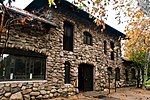Heritage Square Museum

Heritage Square Museum is a living history and open-air architecture museum located beside the Arroyo Seco Parkway in the Montecito Heights neighborhood of Los Angeles, California, in the southern Arroyo Seco area. The living history museum shows the story of development in Southern California through historical architectural examples. The museum focuses on interpreting the years 1850 to 1950, a century of unprecedented growth in Los Angeles. Volunteer interpreters give thorough tours that incorporate the history, architecture, and culture of the region. Other specialized living history events, lectures, and items of historical interest are given on a periodic basis.
Excerpt from the Wikipedia article Heritage Square Museum (License: CC BY-SA 3.0, Authors, Images).Heritage Square Museum
Arroyo Seco Parkway, Los Angeles Lincoln Heights
Geographical coordinates (GPS) Address Website External links Nearby Places Show on map
Geographical coordinates (GPS)
| Latitude | Longitude |
|---|---|
| N 34.088138888889 ° | E -118.20830277778 ° |
Address
Heritage Square
Arroyo Seco Parkway
90065 Los Angeles, Lincoln Heights
California, United States
Open on Google Maps








